This article was floating around Facebook and shared hundreds of times. I’m not sure if you’ve seen it or not…I copied it here, minus the ads and commercials, which is much easier to view. There are a total of 99 photos – some are new to me, and I’m certain a few will probably piss some of you off. Sorry ’bout that [xin loi]!
The Vietnam War was one that changed the landscape of North America and the entire rest of the world with it. In 20 years, some of the most iconic moments in history took place, and we were lucky enough to encapsulate some of those transforming seconds in the form of photographs.
Smiles, Diddy bags, and fun games

The Red Cross was a huge part of the Vietnam War and was mostly made up of volunteers. The Donut Dollies ran recreation centers in large base camps, but their primary jobs were to be mobile. Despite their names, they did not serve donuts in Vietnam as that was a WWII gig. Instead, these girls wrote audience participation game shows, put them in a large green bag, and jumped in a chopper, or a jeep or a truck…whatever could take them to the firebases and LZs, where they literally played games with the troops and passed out ditty bags or other goodies sent to them. The special games were designed to take their minds off the war and provide overall morale-boosting socialization during such an otherwise dark and deadly time. I stopped by the rec center in Cu Chi and visited every time I was sent to the basecamp.
A special thanks to Ms. Barbara Lilly, a former Donut Dollie, who contacted me about the incorrect captions for both DD photos in this article; both are now changed as a result of her input. If you’d like more information about the Donut Dollies, Barbara said that TUBI tv (free) has a movie download titled “A Touch of Home”.
Just a Little Snuggle

Vietnam boasts a lot of snakes, with most of them touting the terrifying title of being deadly and venomous. One of the deadliest kinds, however, doesn’t pack a toxic bite, but rather a breath-defying type of embrace. This longest snake in the world, known fondly as the reticulated python is a snake that isn’t just huge but loves a big ol’ hug—one that will literally squeeze the life out of hug-ee in mere moments.
Raquel Welch Supports The Soldiers
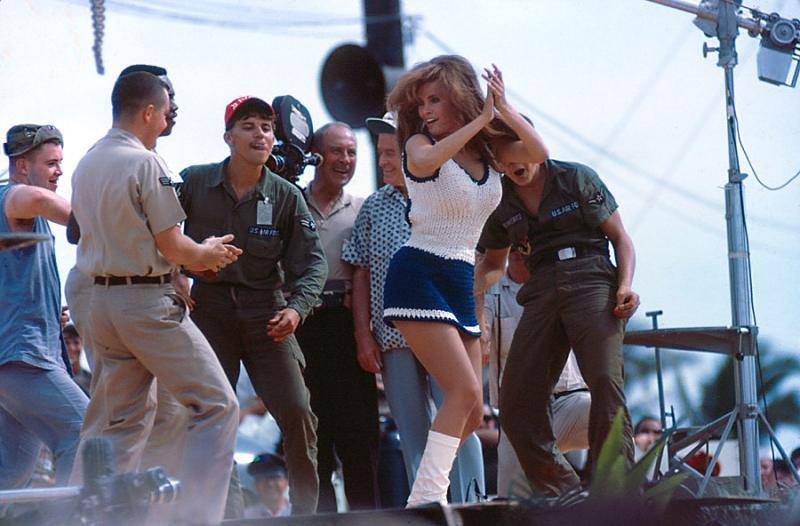
Back in the 1960s, Raquel Welch was the sexiest woman in the world (to be honest, she had held this title for decades, and arguably still does even in her 70s). Right before the Vietnam War had come to its ugly head, Raquel had starred in her sexiest role to date, and following right off that, she decided to do tours overseas with actor friends, such as Bob Hope, to visit with the active soldiers. Always an avid supporter of the soldiers, Raquel was always up to do everything she could to offer any aid in any way she could.
Surf’s Up, Soldiers!
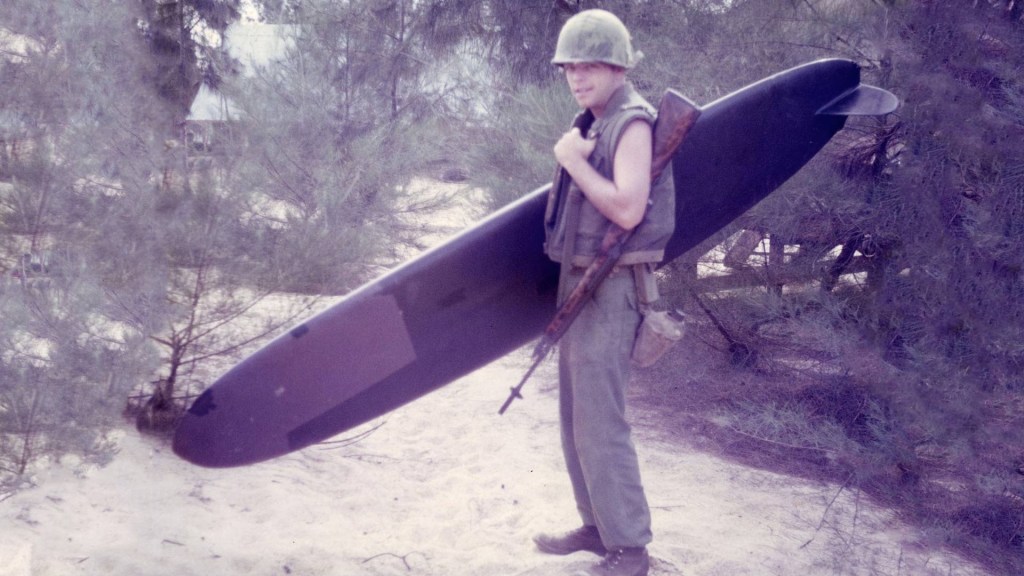
Out of the 3 million men that served in the Vietnam War, many of those from the west coast were surfers in their pre-war lives. The Vietnam War was full of heartache, fear, and overwhelming, unimaginable stress for the soldiers, so they had an idea to bring a piece of their once laid-back lives into the picture to help manage the terrifying times. Soldiers would tell their captains to order surfboards as “life-saving devices” for the water, and it got the job done. Surfboards on hand, this leisure activity was the only they could do to ease the fear.
Joey and the Boys in Camo
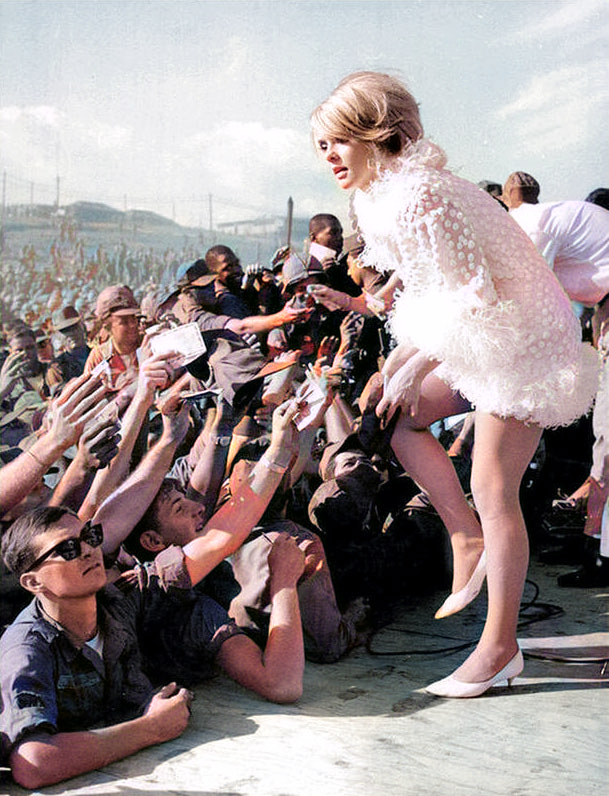
From Bluebeard to Where Love Has Gone, blonde bombshell Joey Heatherton was the sexy vixen of the 1960s, with huge fame and tons of talent to boast within the acting, singing, and overall performing world. Though the media pitted her as “Ann-Margret’s Rival”, the two actually worked together for years with Bob Hope’s troupe of entertainers in Vietnam for the soldiers. Joey wouldn’t do much work after Vietnam, but it didn’t matter. She is one of the most renowned entertainers in history, with most of her accolades being thrown to her work in Vietnam.
Taxi, Take Me Home!

There were so many prisoners of war during the Vietnam conflict—over 700 U.S. soldiers and civilians alone. In 1973, an agreement was signed to send them all home, and it was a huge celebration among all the POWs in complete disbelief that this was finally and actually happening for them—true freedom. A plane was sent to pick the POWs up, which now has become known famously as the Hanoi POW Taxi, and this photo shot perfectly encapsulates the pure joy of those who’d been kept prisoner by the enemy for so long.
The Queen of Comedy Has Arrived!
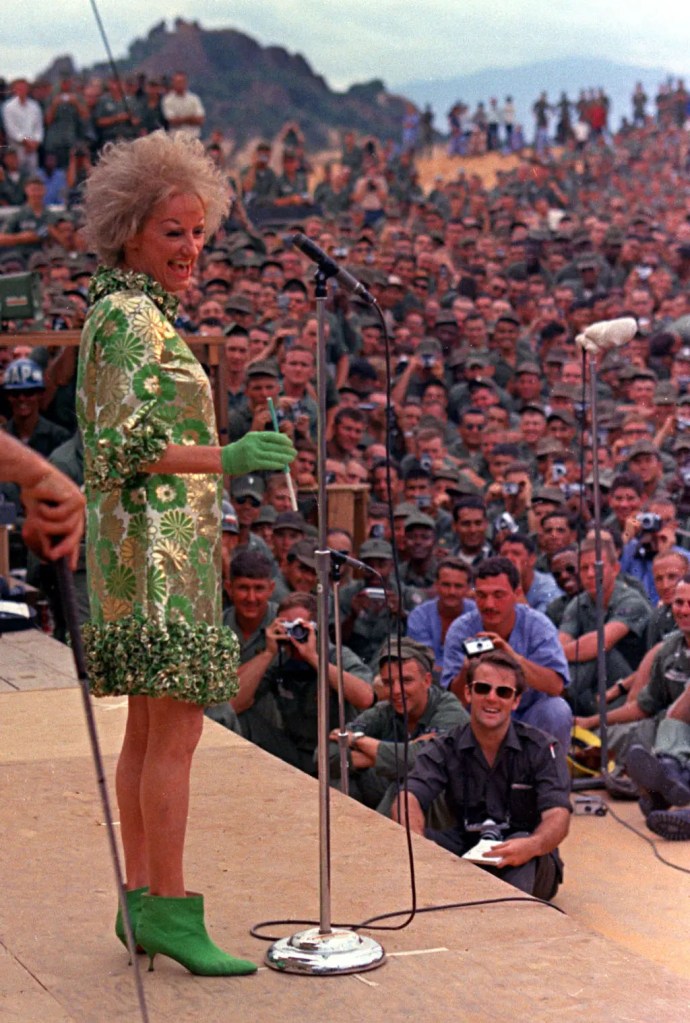
The comedy of variety show entertainer, Phyllis Diller, still remains unmatched to this day. Phyllis had so many Emmy awards and different hit TV shows to her name, so when she decided to join the equally famous Bob Hope on one of his USO tours, the troops were beside themselves with delight. No one could portray that slapstick, unrelenting comedy quite like Phyllis, and when she performed for the troops in Vietnam, she did not disappoint.
Buds Up, Guns Down

In this photo, we see a woman offering a flower to a soldier. This was a common scene during protests during the Vietnam War—a strategy to offer an image of peace along with the message the protestors were trying to spread. The idea was to pick an emblem that was a completely opposite side to the coin of guns and defense, hence why “flower power” was born. At first, doves were used with this idea in mind, but flowers took on more popularity as they were easier to get for anyone, and just a more practical peace offering all together.
These Boots Were Made For the Troops
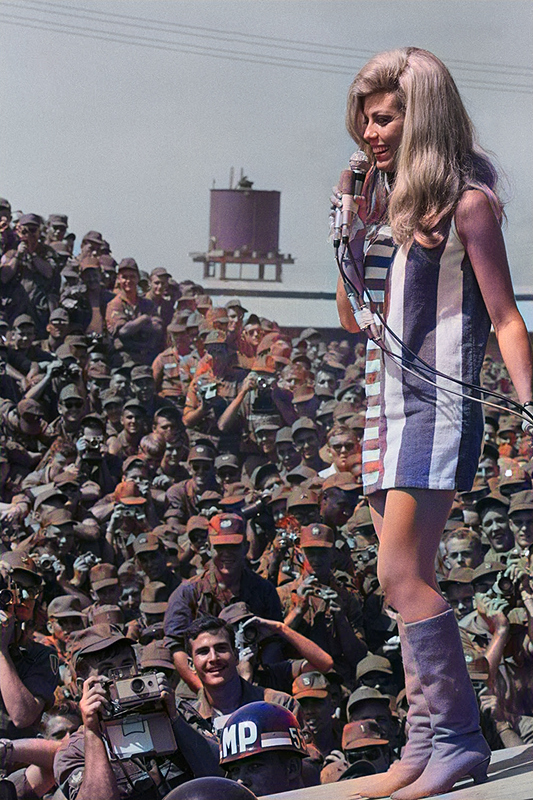
Nancy Sinatra was among one of the most beloved and favorite acts of the Bob Hope USO Tours in Vietnam. Nancy not only performed, but she also did several meet-and-greets and mingled with the soldiers. Her biggest belief was that supporting the troops in this way was extra special to her because in some way, her entire generation was attached to a Vietnam vet, whether that was knowing someone that was drafted, a parent, a sibling, or involved with war support/protest.
President Lyndon B Johnson
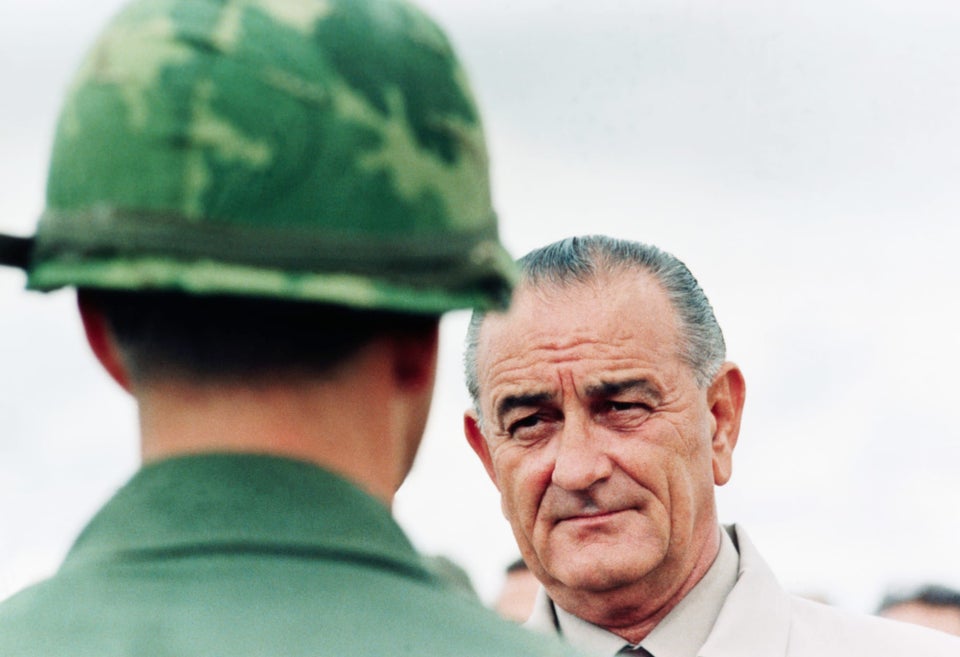
This raw photo is one that shows candidly how the Vietnam War had a profound effect on even the most powerful people of the time. U.S. President Lyndon B. Johnson sits here, head down as he listens to a recording from Marine soldiers on the front lines in Vietnam—one of which was his own son-in-law. With the draft in place, not even the top politicians could save their own families from fighting in the war, and here, we see that even someone as powerful as a president of a country is brought to his knees knowing his child is in danger.
Most Beautiful Woman in ‘Nam
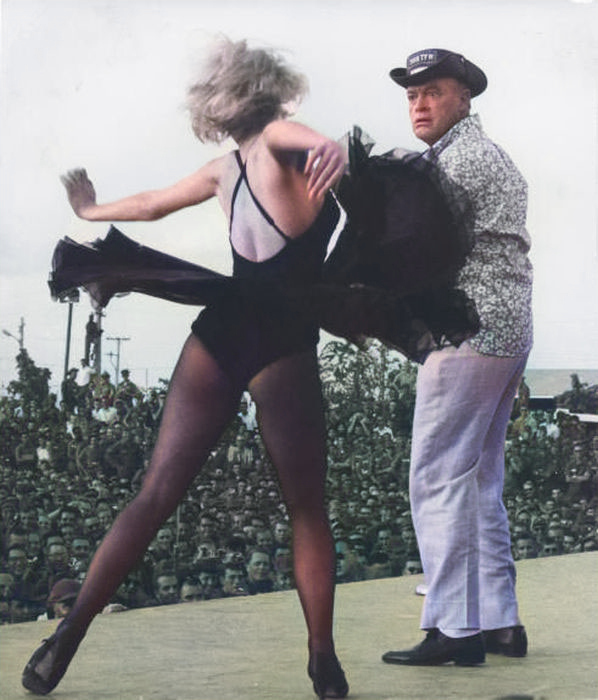
Sex symbol of the 60’s—right up there with Raquel Welch—Joey Heatherton toured with Bob Hope’s USO tours to Vietnam for over a decade, and it’s not like she didn’t already have big fame on her plate back home. Joey was already famous for her acting, dancing, and performing for big shows and films, but it was her work with the Vietnam War soldiers that really gave her a name that would live on forever.
Two-Step Charlie, Over

A non-venomous snake that squeezes its prey to death isn’t the biggest worry about the slithery species that soldiers had to worry about in Vietnam. No, there was a much smaller little guy that scared the wits out of men walking through the tall grass in Hanoi. Known as a “two-step”, the krait snake would strike after just 2 steps near it, before you’d know what was going on, and its toxic bite would kill a man in mere seconds.
Bringing A Little Soul to the Jungle

Sammy Davis, Jr. was famously against the war in Vietnam, but when the President asked him if he’d be up for the challenge of traveling overseas to perform for the soldiers, Sammy’s answer was an immediate yes. Much like many other performers who would tour to entertain the troops, agreeing with war wasn’t hand-in-hand with being there for the soldiers when they needed it the most.
Auditioning for Doughnuts
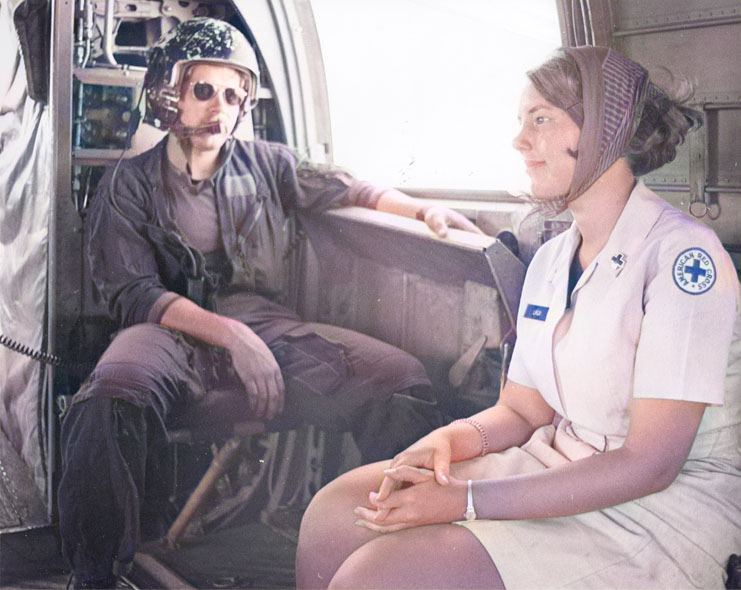
The Donut Dollies actually had higher standards for joining and being active in the Red Cross than the boys in the military. The Red Cross Supplemental Recreational Activities Overseas (SRAO) initiative set the rules—the girls had to be completely higher-level educated (college graduates), 21 years or older, and come with several letters of recommendation from prominently recognized U.S. citizens. Higher than average physical exams also had to be passed, along with someone subjectively deciding on whether or not these girls had what was deemed “outstanding personality”.
Here Comes the Cavalry

In March of 1965, over 23,000 military men were already stationed in Vietnam, but 3500 more Marines would join them, landing on the beaches of Cape Batangan. From defense aid to searching for Vietcong guerillas as they trenched through murky marshes, troops would look back on this time as the true moments that the war really began. It also has to be noted that the bravery of TIME photographer Paul Schutzer was on display, as he was also on the front lines capturing these harrowing moments so that those back home could see just how intense the war really was.
From Sea to Shining Sea
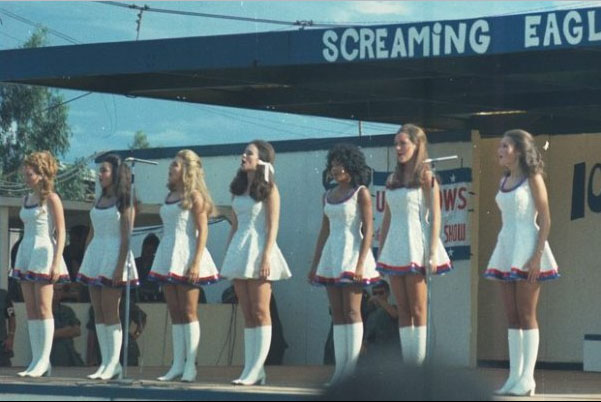
Another USO that provided a bit of entertainment was a Miss America Show a few years into the Vietnam War. This big group of women would only dress in patriotic attire, and they would perform the best of the best dancing and entertaining acts on stage for the soldiers. It was an exciting time for the men in the middle of a war, as most of them hadn’t seen their wives and girlfriends for upwards of years sometimes.
The Ultimate Doggy Treat

The puppy in this photo is a stark contrast to everything else, such as the rounds of ammo belt, the fatigues, and the soldiers caked in mud and oil. Though the Vietnam War was a dark 20 years of time, there were lighter, rarer moments like this, too. The soldiers fought and strategized military stationing just about everywhere—even in man-dug, underground cave-like holes seen here. It was this lost puppy’s lucky day, and by the look on the soldier’s face, his, too, when the little dog was found by accident in this manhole.
New Meaning to Pop Tops
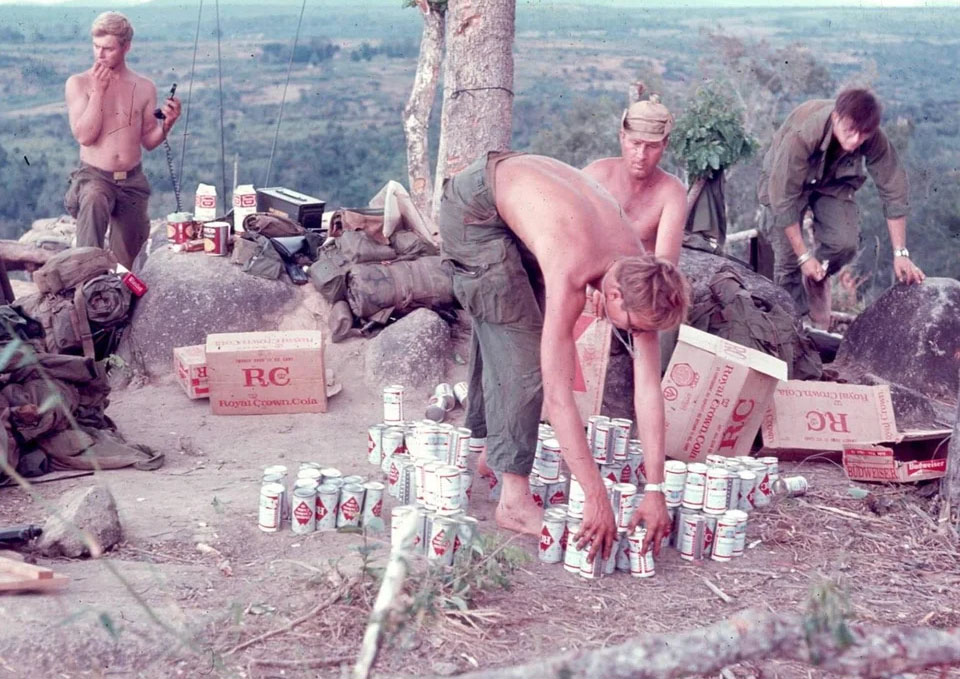
RC Cola was America’s most popular soda from its conception during the Second World War, and popularity only soared when new technology at the time of the Vietnam War put the sugary beverage into a pop-top can. The convenience, portability, and nostalgia it offered to soldiers fighting in Vietnam were huge, but a problem arose early on with these refreshing sodas. The soldiers would toss the cans after they were finished, only for the enemy to slyly sneak up and easily turn into small bombs to use against the U.S. military.
When it’s Too Hot For Clothes in ‘Nam…
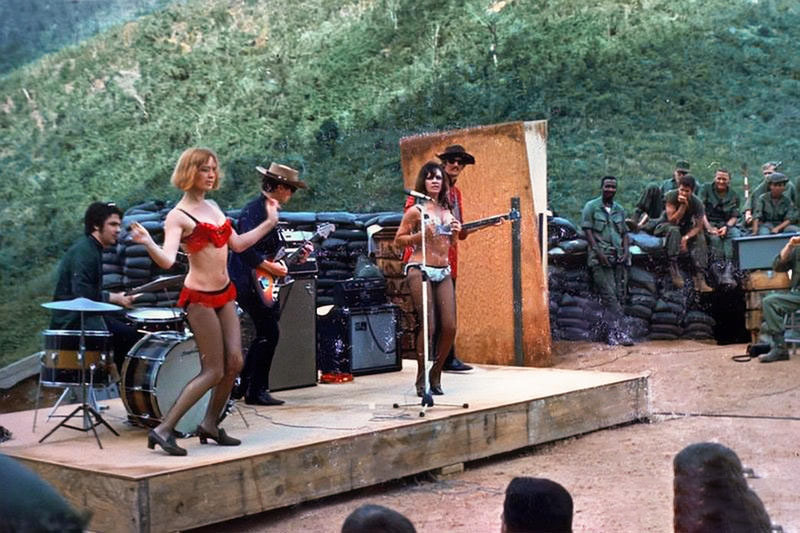
Bob Hope is who everyone still talks about as leading the celebrity entertainment to the soldiers in Vietnam, but he definitely wasn’t the only one by far. Shows for the troops weren’t just limited to song and dance, but also to more adult forms of entertainment, from go-go dancing to stripping to other more private services. There were actually performers employed by the USO that would come perform for the troops, and there were also tons of local entertainers from surrounding cities like Bangkok who would come in and provide shows for the soldiers.
Life’s Like A Box of Chocolate

While not coming to our screens until decades later, the beloved classic Forrest Gump portrays life around the time of the Vietnam War—both in the war and beyond—brilliantly like few other films have been able to do. The movie and its star, Tom Hanks, covers everything from the intensity of the war, death, PTSD, the hippie movement, the drug pandemic, and how the era ultimately changed the face and direction of the U.S. indefinitely.
The First Lady of Vietnam
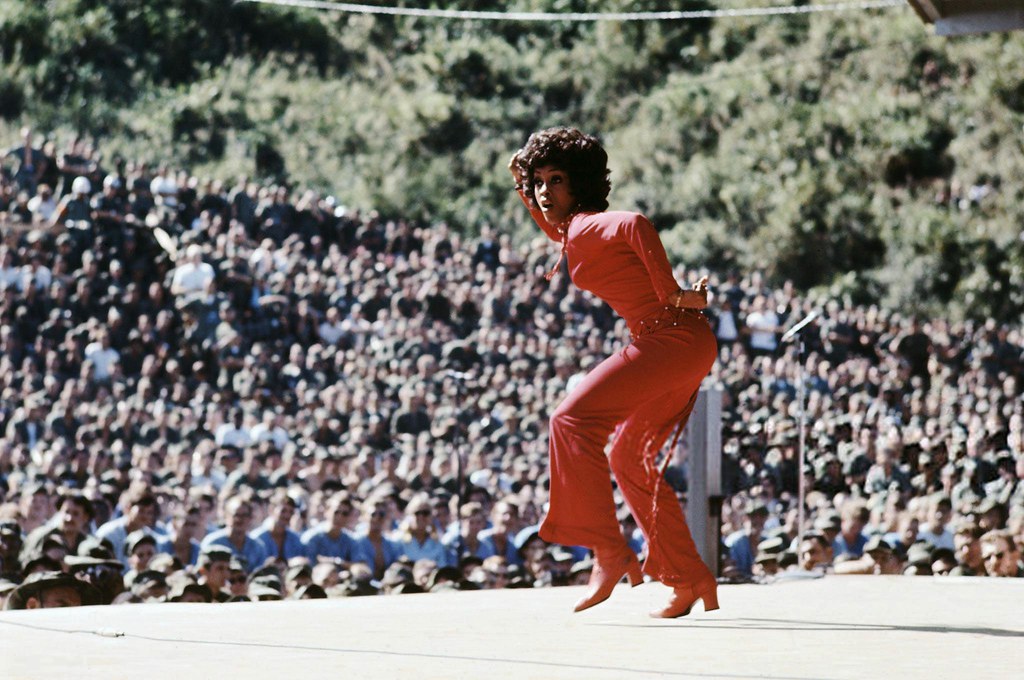
Bob Hope held his final USO tour in 1972, and world-famous actress, singer, and model Lola Falana joined the troupe in its last run. She can be seen here in this picture working it on the stage with her mad talent for the troops in Da Nang, and this First Lady of Las Vegas didn’t skimp on anything for the soldiers. From glamourous costumes to impossible dance numbers, Lola used every second she had on the tour to bring the troops some joy.
A Clever Reading Nook

Over 700 military tanks were used by the U.S. in the Vietnam War, and while they all ran defense, that defense didn’t always look the same. Case in point seen here, as these soldiers enjoy leisure time reading and relaxing (as much as was possible in the middle of a war, anyway) with their tank. Frequently, many of these war tanks were used in a way in which they were stationed in the front of military bases as a hefty line of defense. Most didn’t see a lot of action, so soldiers did what they could to pass the time on their shifts in the sweltering heat.
Bringing Cute and Sassy to the Jungle

Jane McClellan and her all-girl band, The Debutantes, were an obscure group who had sporadic success in and out of the 60s, but what they’re best known for was the big tour they took overseas with the USO to entertain the troops during the Vietnam War. With the war raging on, smack dab in the middle of its reigning decade, the Debutantes knew how to entertain in the classic old way of the Beatles; with pizazz, jokes, and playing all their own instruments.
Lady Liberty Stands Tall

Flower power wasn’t the only way anti-war protesters chose to spread their message in creative, peaceful ways. This photo captures a time 6 years into the Vietnam war in which protesters (veterans and non-veterans alike) utilized the iconic American symbol of the Statue of Liberty in New York to drape huge banners across the crown. The banners were simple yet effective in the message, and protesters would even type up several letters to President Nixon to pair with the banners in an effort to persuade him to end the war already.
Well, That’s A Stick In The Mud

One of the toughest things about the Vietnam War was the landscape. Vietnam was known for not only temperamental weather but also extremely wet conditions most of the time. The humidity, rain, and swampy atmosphere never let up, resulting in unforeseen and unavoidable situations like the one in this picture. This army truck had no hope against the dense, sinking mud, and soldiers had no choice but to pull out all stops to get their convoy unstuck. As we can see, most of the time, efforts could be futile and soldiers would have to wait it out for backup to help, and pray there was a letup in the rain.
Forecast for the Day: Sunny!

Bobbie Keith was much like the Doughnut Dollies of the Vietnam War, bringing entertainment and a bright moment to soldiers on the front line. And also, like many in the Red Cross, Bobbie was a volunteer and unpaid. Bobbie was already a step ahead of the game, though, as she grew up in a military family and had lived in war-torn places all over the world before she got to Vietnam. In just the 2 years she reported the most entertaining and uplifting weather segments for the troops, she made quite the positive impact on morale.
Sun’s Out, Guns Out
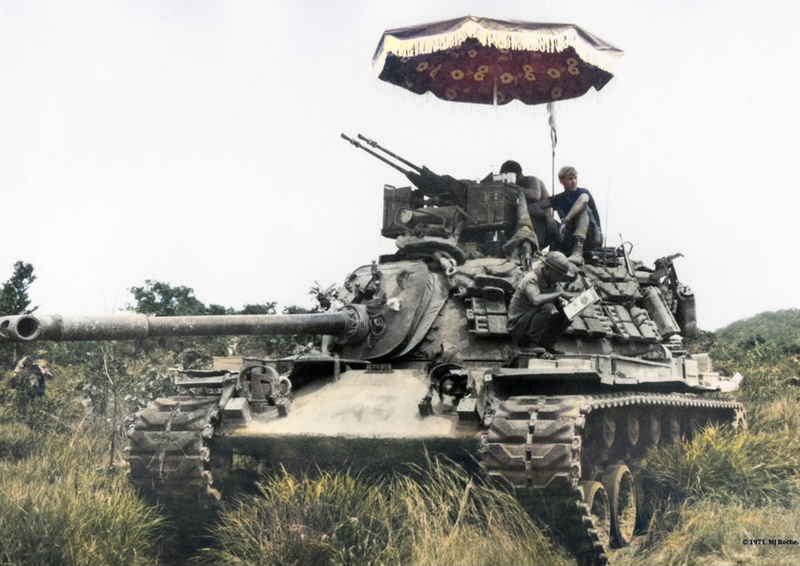
Tanks were more than just defense weapons in the Vietnam War. They also posed as years-long homes for a handful of soldiers. No matter what the troops assigned to a tank were tasked to do, that tank was their shelter and solace, day in and day out. Soldiers were known to get innovative when it came to decking out their tanks, for both functionality and décor, as seen here. These soldiers chose to use a local design umbrella to offer an original aesthetic while shielding them from the relentless sun.
Here Comes the Doughnut Wagon!
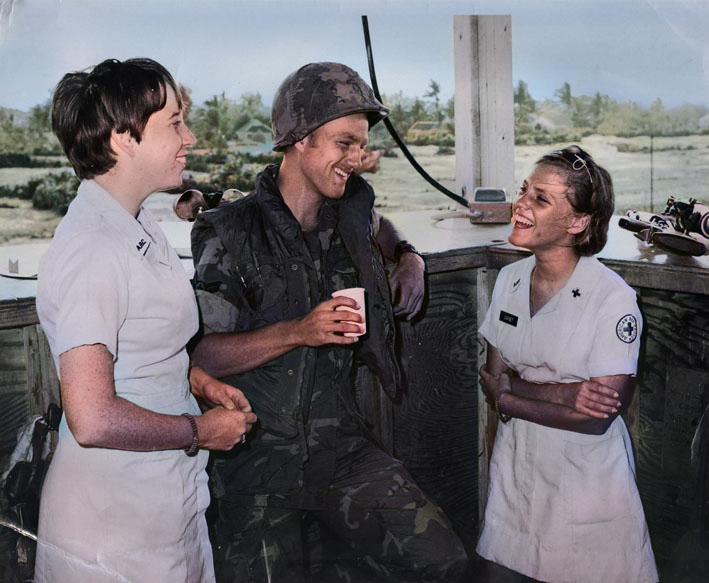
627 women would serve as the historically renowned Donut Dollies during the Vietnam War, but their inception actually started in World War II. Beginning as a bright idea from a New York Banker and a main ambassador to the British Red Cross, the Dollies started out with just a trolley van, and while entertaining was always on their list, making fresh doughnuts for the soldiers all throughout Europe and Britain was the biggest thing they could pull off at the time in such a small traveling van; hence, the darling name that stuck.
A Star Is Born Way Before Hollywood

Kris Kristofferson is not someone small in the world of fame. He’s a hit singer/songwriter, actor, and extremely educated in the field of literature and cinema. He bumps elbows with some of the most famous people in the world and Kris is a proud Army veteran, who flew helicopters in Germany. Kris has always been extremely outspoken with his strong opinions about how he feels about war and soldiers in general, lamenting that he will forever be the strongest supporter for those in battle, but never for those who send them there.
My friend, Marc Yablonka send me the following story about Kris: When he was pushing a broom at Columbia Records in Nashville trying to make it as a songwriter, he wrote the song “Sunday Mornin’ Comin’ Down” for Johnny Cash. He tried every angle in the book to get the song to Johnny–Cash’s producer, publisher, manager, recording engineer. All failed. So one day, he decide to rent a chopper. He flew it right into Johnny’s backyard and hopped out of the chopper with the rotors still going. Johnny came running out and yelled, “What the hell is going on here?” Kris told him, “I’ve been trying for weeks to get you this tape, Hoss! Here!” He got back in the helicopter and flew away. Johnny recorded the song and the rest, as people often say, is history!
One Stupid Decision…

Jane Fonda was a big name in the 60s and 70s, due to being born into Hollywood royalty, and also for her own work in big films opposite A-List stars at the time. Jane was extremely anti-war and spoke at several rallies. However, Jane made a decision that ultimately some would say cost her what could’ve been a huge career. She went to Vietnam to protest a legitimate concern over non-war targets being bombed, but when Jane decided to pose in a photo smiling with the enemy Vietnam cavalry who had killed, maimed, and bombed countless U.S. soldiers, she was re-named Hanoi Jane by practically the whole U.S. at large.
On-Call Barber

Military requirements for haircuts have changed many times over the years, and in Vietnam War, though the hippy long hair of the decade was popular, no one was sporting that as a soldier. Mustaches were still allowed, and in the Navy, beards were allowed as well. But the high and tight was the way to go, which meant a barber had to be on hand on base at all times. Today in war areas, a lot of times those jobs are given to locals of the region, but during Vietnam, it was normally an American who traveled with the bases.
Up In the Air
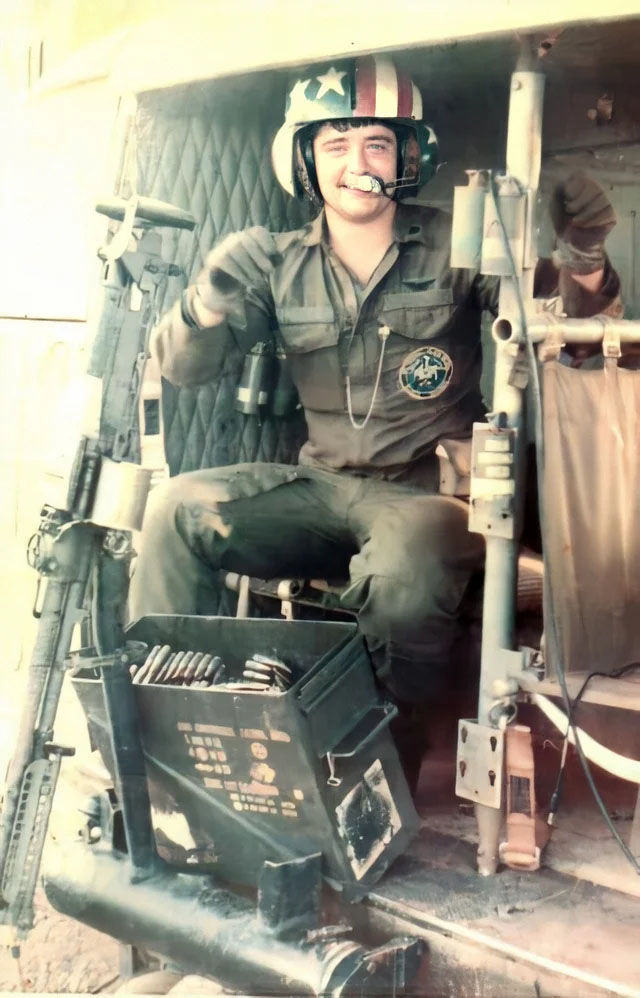
America lost over 10,000 aircraft during the Vietnam War, which goes to show just how heavily the entire war itself was utilizing the power and defense of airstrikes. But unlike what we see in the movies, aircraft, and pilots like in this photo, weren’t always attacking and saving troops from enemy assault. In fact, many of the planes, though of course always equipped with necessary weaponry as seen here, were really shuffling planes for cargo and big groups of troops.
King and Queen of Morale

In one of their USO tours together, Bob Hope and Ann-Margret can be seen in this shot enjoying their work in performing for the troops over in Vietnam. The comfortability we see here speaks volumes of how their support for the soldiers outweighed the massive amounts of danger that Bob and Ann put themselves in every time they traveled on a USO tour during the Vietnam War. It’s clear that the troops could see it too, as the performances would become a huge morale booster during the war.
Hats Off To Ya!

Soldiers in the Vietnam War were big on decking out their helmets in personal things, and this photo showcases this particular soldier’s big love for his girl back home. Made in the way of ingenuity in the form of an elastic band, this soldier could easily take the band off for situations in which the photos might get damaged or in the way. There is a certain sadness to the photo circle, as it starts out with the 2 of them and becomes solo photos of just her back home without him.
Get to the Chopper!

Helicopters played many vital roles during the Vietnam War. They were used as attack weapons towards the enemy on the ground in a big way, but they also posed as the main transportation source to resupply bases with whatever they needed, whether that be troops, ammo, or the hundreds of other things needed to fight a war. They were also used for defense and fire help for the troops, as seen here, flying low and close to offer an extra shield of protection from either enemy combat or brush fires from dropping bombs.
Guidebook for Marines
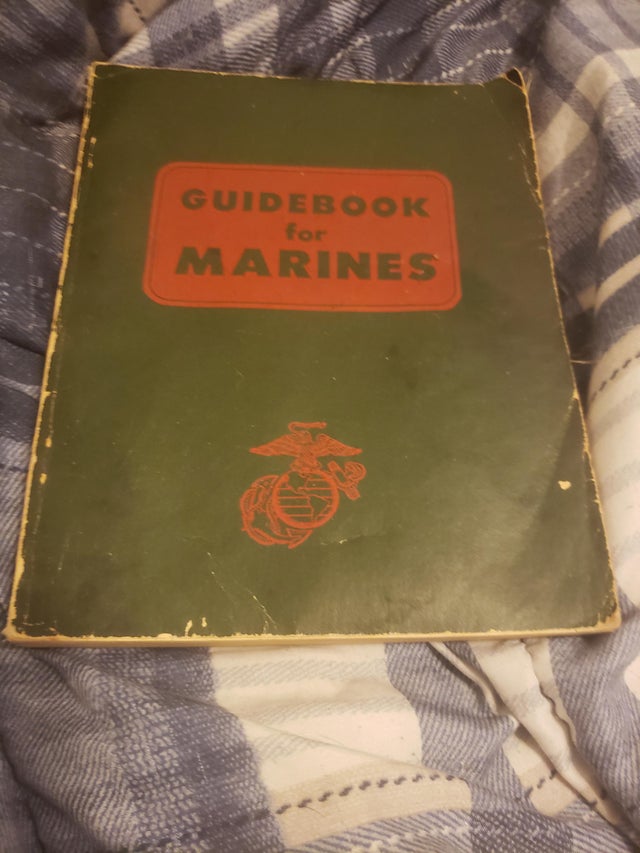
The Marine Corp refers to the year 1968—a.k.a. the middle of the Vietnam War—the “defining year for the Marines”. While they had this edition of a guidebook going into the war, it would in no way prepare the Marines for what would be the deadliest battles they would face to date in Vietnam. The Battle of Hue would change the face—and all future guidebooks—of the Marine Corp, and to give you an idea of how brutal this battle was: 120 Marine soldiers went into the battle to fight, while only 39 would come out alive.
The Troops’ Sweetheart

While Bob Hope’s name seems to be synonymous with unwavering support for the troops and constant USO tours, so does Ann-Margret’s name. The ultra-famous actress, comedienne, and singer extraordinaire would tour for the troops in Vietnam 3 times, and would later write in her autobiography that it was the most rewarding years of her life, even surpassing her acting career. In this photo, we can see Ann arriving for her first-ever USO tour in Phu Bai, after receiving a request signed by 3000 soldiers overseas asking her to come.
Modern Day Robin Hood

Most people don’t think about archery in more modern war, but here we see a soldier with his bow and arrow aiming down a swamp in the Vietnam War conflict. This wasn’t a rare thing during the Vietnam War to see Special Forces units using 1 of 2 types of non-automatic bow and arrow weapons. In a local Vietnamese village, Montagnard, the townspeople used a specific crossbow they’d created that didn’t look fancy but was one of the deadliest in history, and so soldiers befriended and adopted the use from them.
Give Peace A Chance

The legendary John Lennon is remembered for being a Beatle and for his loud support of the peace, anti-war movement with his wife in the late 60s into the 70s eras. When John and Yoko were first married, they chose to use their honeymoon as what they called a “bed-in”, in which they invited in all reporters to their hotel room at the Amsterdam Hilton and chatted for 12 hours about the concept of peace. It sounds a little bonkers, but it worked to get their message out to the world, as they were featured in books, on magazine covers, in newspapers, and John even released a hit song about it.
This One Really Bugs Us
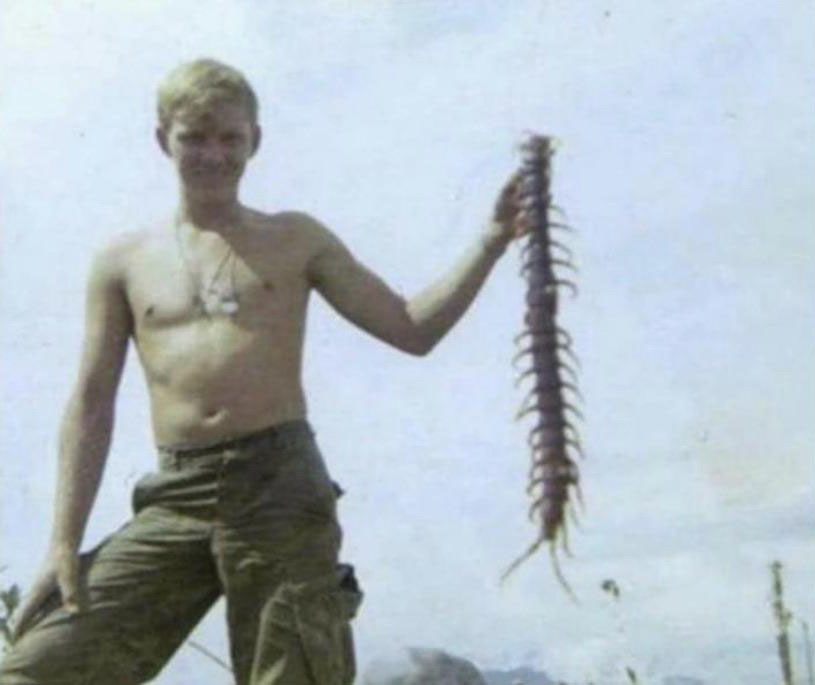
You’ve heard of a centipede, but have you heard of a jungle centipede? These monsters, like the one in this photo, are not fake. This is a real Vietnam War Army vet holding up a real, true-to-size jungle centipede. There is, however, a catch—the vet holding up the centipede is actually the one taking the photo, and these 2 jokesters are using the manipulation of size perspective to make a 10-inch-long bug look nearly 3 feet. Well done, soldiers, you sure fooled us.
The Hanoi Taxi Lives on Past Vietnam

The Hanoi Taxi may be retired out of use now, but it still can be seen at the National Museum of the U.S. Air Force in Ohio today. This aircraft actually got its name from the POW’s it rescued themselves, as they scrawled the words “Hanoi Taxi” on the engineering panel, forever engraving it into the legendary plane. What’s especially cool about this aircraft, is that it would be used later for the same kind of rescuing mission, deployed during Hurricane Katrina to those stranded amidst the hurricane chaos.
They Call Me Huey

Known more fondly amongst soldiers and in war movies as the “Huey”, the Bell UH-1P helicopter actually originally was produced just a couple of years before the Vietnam War would officially begin. They were so popular and widely used in the Vietnam War, that the Huey became an iconic fixture synonymous with the war itself. Though at first, the Huey’s were made as a support helicopter for bigger, tougher defenses, very soon on, they became the prime combat aircraft in the war.
The Cat’s Meow

Stray dogs and cats were everywhere in Vietnam, and cats specifically were part of a cat meat trade. Any time a soldier, volunteer, or anyone working in any capacity on base in the war found a stray animal, it was almost a no-brainer to save that cat from becoming someone’s next meal. Typically, these animals would be adopted into a unit, and become known as the base cat, who was fond of all the soldiers and workers in that particular tent group.
Raquel Welch Hits the TV’s Back Home
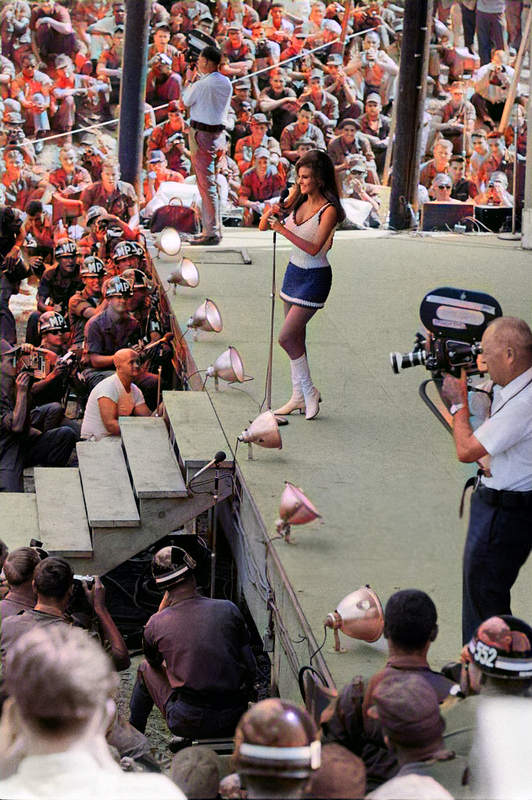
In another great shot of Raquel Welch making the most of every moment she got to entertain the troops on Bob Hope’s USO troupe tours, you can see the happiness not just on her own face as she was able to have this opportunity, but also on the soldiers’ faces in the audience. And as the first televised appearance that the U.S. back home would have a chance to see, she would later tout this time as her proudest achievement in her career that meant the most to her.
Who’s Ready for a Road Trip?

MASH didn’t come up with the Home Post Signs all by itself. In fact, these types of signs were already a thing in the Vietnam War. The war raged on for so long that homesickness and depression were a common theme among the soldiers, so in the way of dark humor, they decided to make signs reading where they were from and how many miles away that place was. The idea was to pretend that no matter what was going on, home was just a “quick” road trip over the water.
Taking Requests

The Vietnam War was full of violence, terror, and extremely dark battles for everyone there, but there were also many stretches of torturous waiting in which not a lot was happening. This served to be an especially tough time for soldiers, piling on the already-heavy homesickness that ailed them. From surfing to picking the guitar as we see here, troops would do just about anything they could to pass the time and keep themselves out of their own heads.
Light ‘Em Up

Soldiers in the Vietnam War didn’t have many possessions while they were deployed, but one of the main items most of them did have was a Zippos lighter. The boys treated these like gold, so they would mark the lighters up to claim them as their own to keep others from taking them. This mantra seen on this lighter in this photo was a phrase largely circled and carved on lighters by many soldiers. You can still find these artifacts circling Vietnam War auctions even today.
Viva Las Vietnam

Bob Hope’s first USO tour to Vietnam would cover over 25,000 miles and Ann-Margret was there every step of the way. Here she can be seen performing dances and tunes for one of the many stops she made for the troops in the Vietnam War. Even later in her life, Ann continues to talk about how much she loved doing the tours and that being able to do what she could to support the troops was the proudest moment in her life.
Real Hope Was All in the Name
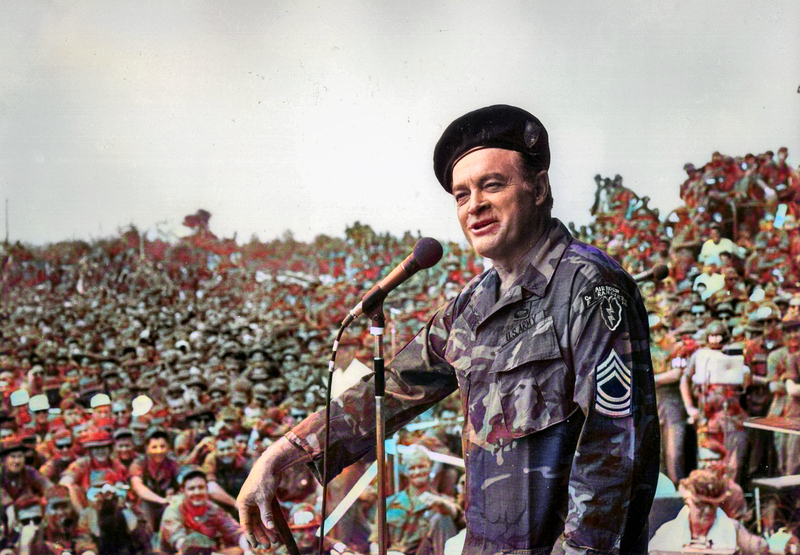
He’s been mentioned many times on this list, but the man of the hour more than deserves it. Bob Hope, the leader of the supportive movement in forever boosting troop morale in Vietnam, put together several troupes shows full of celebrity supporters over the 1960s. He and his group would travel to the war-emblazoned battlefront of Vietnam, all over, to offer shows of comedy, singing, dancing, and overall entertainment in support of giving the soldiers a much-needed moment of joy in an otherwise extremely dark time.
The Old Reliables

Also known as “The Old Reliables”, the 9thInfantry Division of the Army was the most important unit in WWII and Vietnam alike. They were a huge protective force very deep in the Viet Cong, offering defenses and warding off the likes of big communists threatening to topple the more peaceful government that South Vietnam was attempting to create. The Old Reliables had a tough job that required ultimately defeating the commies while trying to keep peace and help build a government that would protect the country and economy of Vietnam.
The Truest Hero Finally Sees His Freedom

Former senator and U.S. presidential candidate contender, John McCain was not only a naval aviator in the Vietnam War, but he was also a prisoner of war held for over 5 years. During his time as a POW, he was tortured endlessly for not revealing the names of the men in his squadron. Here, in this 1973 photo, McCain’s release is shown, and though he would go on to leave a dedicated life to patriotism and politics, he would never be able to lift his arms above his head again due to the POW torture he endured.
Dropping Patriotism and Stereotypes
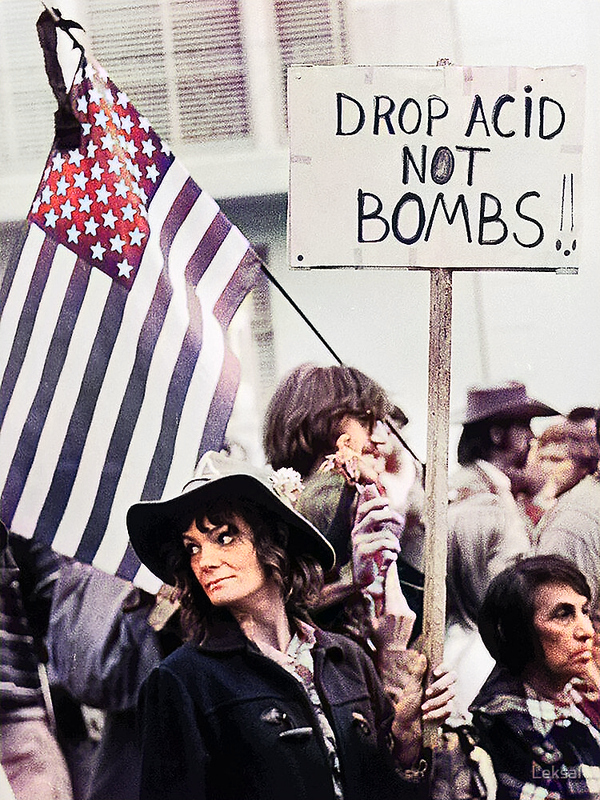
In a notably creative turn of phrase, Drop Acid, Not Bombs, protestors of the Vietnam War created a slogan to attempt to get a pretty solid message across—you can both be patriotic to your country while opposing the ongoing war in Vietnam. Unfortunately, the stereotype that seemed to follow hippy protesters (i.e., unemployment and heavy hallucinogenic drugs) was a hindrance in trying to spread a well-thought-out level of thought.
Sting Like A Bee

Muhammad Ali refused to draft during the Vietnam War conflict due to war, in general, being against his religious beliefs as a Muslim. Because of standing true to his beliefs, Ali went from a prized fighter to unemployed out of the ring for over 3 years. But Ali would use that time out of the gloves to be a traveling speaker for schools, talking about his anti-war views, which aligned with many of the students at the time.
Cassius Clay vs. the U.S. Government
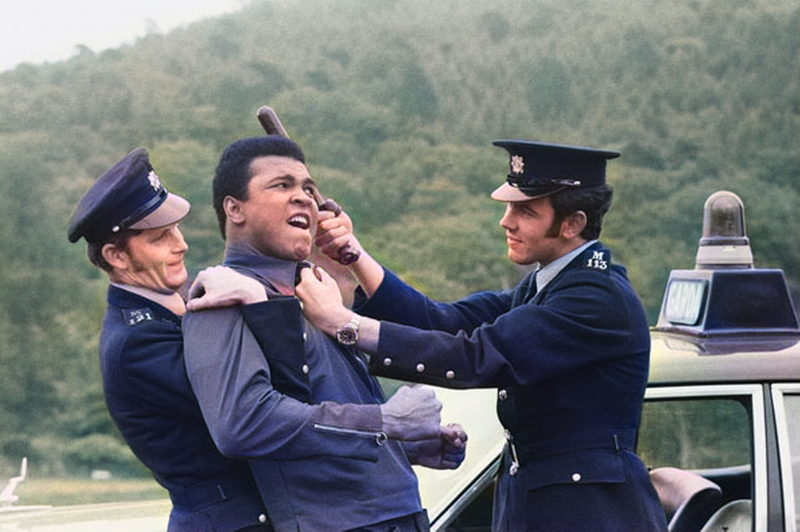
The great boxer, Muhammad Ali, as we know, refused to participate in the Vietnam War due to religious beliefs, but before he took his career slump in stride by becoming an educational speaker on anti-war, Muhammed was actually arrested, fined $10,000, jailed for 5 years in federal prison, and banned from the boxing sport for 3—all by the U.S. government on charges of draft dodging. His career picked back up after the war was over pretty instantaneously, though.
When a Prank Goes Wrong

A bunch of soldiers decided to prank an unsuspecting airman who was terrified of snakes, and it went badly awry. The soldiers told the man to check out a noise they’d heard just ahead near the helicopter. The man did as they asked but then took off running as soon as he saw the injured snake the soldiers had set up there for him to discover. The man ran so far out from the unit that it took hours to find him. Safe to say this episode of punk’d brought up some serious trust issues for the whole unit.
President Johnson Inherits Foreign Abominations

President Johnson was never known for being savvy when it came to foreign policy, as he was more renowned for the projects domestically that were so important to him. In fact, Johnson isn’t particularly remembered for anything he did in regards to across the sea, or for the Vietnam War specifically, other than the huge stress it put on him with his own son-in-law fighting. What Johnson is remembered for is huge reformation in sectors of the U.S. such as civil rights, social security, and momentous tax cuts.
From Green to Blue

Known for his big acting roles in huge procedural cop dramas like NYPD Blue, actor Dennis Franz persona on screen might have just been shaped by his experience as an airman in the Vietnam War. He always maintained that the war changed him in ways that are indescribable, as he’d experienced true fear, loss, massive amounts of death, and the nonstop carnage of the war for years.
Taking War-Torn to the Big Screen
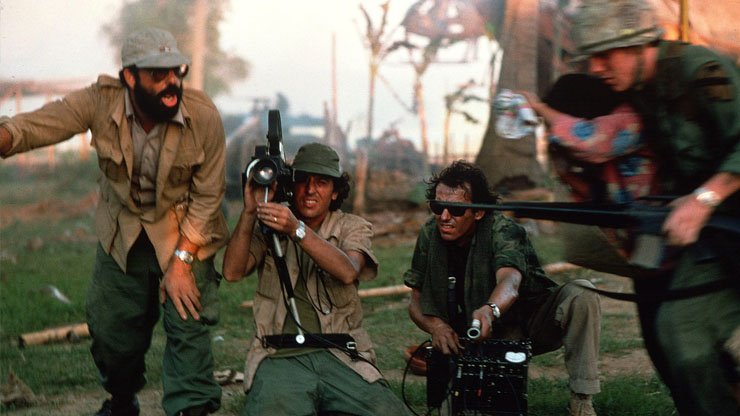
As Forrest Gump tried to showcase what life was like in and back home from the time of the Vietnam War, Apocalypse Now took that to a whole other level and scope. Francis Coppola took the actors and filming to the extreme in his efforts to capture what he thought were the darkest pieces of the Vietnam War and the effects on a man’s reality and psyche truly were. From forcing his actors into method acting in front of the camera nonstop, to never skimping on the violence to portray the real violence the Vietnam War was full of, this movie has made it into history’s top films for a good reason.
We’re Live on TV!
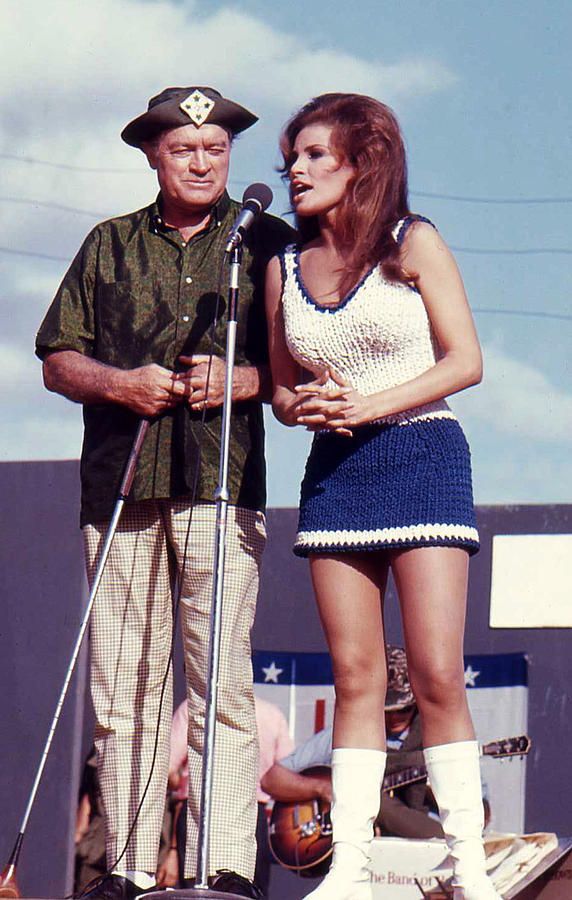
This photo is a particularly special one in the scope of all the USO shows Bob Hope did every Christmas for the troops over the years during the Vietnam War because it was actually the first one that was taped! This way, the rest of the world and those back home in the U.S.A. could really see what was going on firsthand in Vietnam, and just how badly the troops need the morale boost and hope that Bob and Raquel and the rest of the merry gang were providing so many times over.
That’ll Be 2 Vowels and a DJ
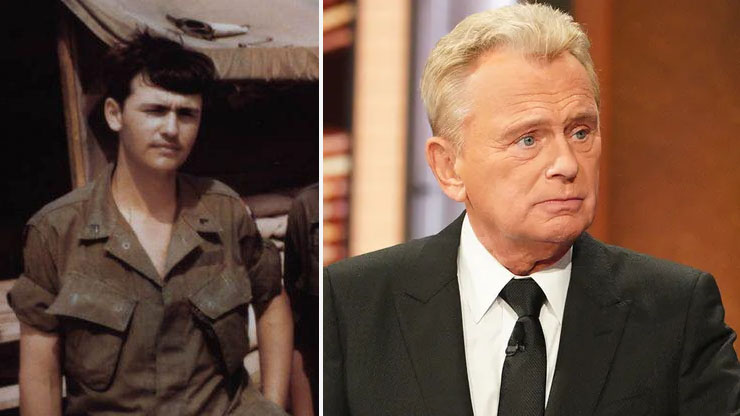
From Bob Hope’s troupes to onstage strip shows to colorful weather reports, the entertainment in the Vietnam War was always geared to boost the morale of soldiers. Our favorite host of Wheel of Fortune was a huge part of this as well! Pat Sajak became the most prominent, entertaining radio DJ of the war. For nearly 2 years, starting at 6 a.m. every morning, Pat would be up, the voice on the radio telling jokes and bringing the soldiers little tidbits of home through the airwaves.
The Legendary Larry Burrows
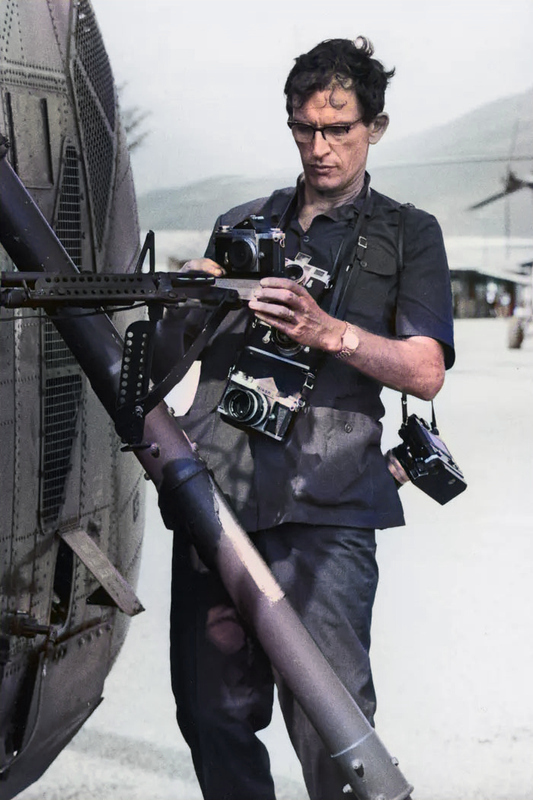
Do you know all the historic photos we still see today on old covers of TIME magazines, books, and television about the Vietnam War? Most of those were taken by renowned photographer, Larry Burrows. His bravery in joining troops in even the most dangerous of front lines and battles is what allows all of us back home to be able to witness the atrocious realities of that war. Larry would go on to photograph the Vietnam conflict from 1862 all the way up to 1971 when he—along with a unit of soldiers—died after being shot down in a helicopter in Vietnam.
The Life-Changing Tour of Raquel

Raquel Welch was a favorite among the guests in Bob Hope’s troupe USO tour shows, but perhaps one of the best stories of her time in Vietnam was in the moments she first arrived. As told through the years by herself and her ex-husband from the time, the flight into the base was rocky, throwing Raquel all over the plane. As the aircraft descended closer to the ground, it was hard for Raquel to see anyone at first, and she started to cry that no one had even shown up. But in the seconds before landing, she truly saw the hundreds of soldiers awaiting her with big signs, and the first thing Raquel did when she got off the plane, was jump into the arms of 2 excited Marine soldiers awaiting her arrival.
A Soldier’s Best Friend

Strays weren’t the only cats and dogs that wandered into military bases for shelter in love during the Vietnam War. Military dogs specifically were used as guard animals, service animals, and even to scout for food and hidden enemies. They were in the war as much as the soldiers day in and day out, so it’s no wonder the troops like this one came to truly love those dogs as members of the unit and family. And what war-torn soldier doesn’t need some serious puppy cuddles during such a terrifying and stressful time?
Brothers For Life

Just under 15,000 troops in the Marine Corp alone were killed during the Vietnam War, so these photos have a really special feel behind them. These 4 buddies loved to surf, and 50 years ago before the war, we see them posing at the beach after they’d first met in boot camp. 50 years later, they all miraculously not only survived the Vietnam War but found each other again so many decades passed.
A Personal Touch

Much like the soldier who made a helmet band decorated with several pictures of his sweetheart back home, helmets were more than just a protective bowl on a man’s head during the Vietnam War. Soldiers would use their helmets as their own self-expression plate, with funny sayings or more serious mantras protesting the war in general. This anti-war sentiment was felt on a larger from during Vietnam, being that so many men were drafted involuntarily.
Honorary Santa Claus

A decade of holidays and Christmases were spent away from home for the majority of soldiers overseas in the Vietnam War, so any little thing they could do or muster up for these lonely times helped the desolation and holiday depression just a bit. The soldiers could always count on Bob Hope’s troupe coming to town, and they would also find trees to decorate with whatever they could find, sometimes, as seen here, a sergeant would dress up as Santa, and the really lucky ones would receive extra special packages from loved ones back home.
When’s the Next Flight to Canada?
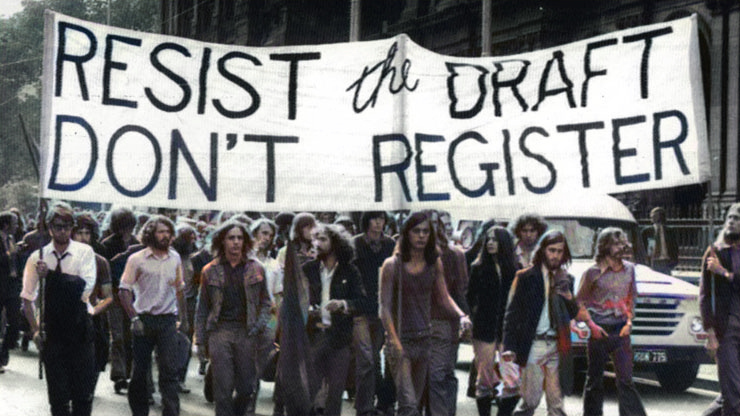
Resisting the draft was no meager choice, as it’s considered a crime against the nation and can include some really serious penalties that are life-ruining, such as prison, fines, and losing employment (case in point, Muhammed Ali). But that didn’t stop many from protesting the draft, and many men sought to run off to Canada during the time of the Vietnam War in an effort to avoid the draft and the punishment from the U.S. government for doing so.
A Soldier’s Heart

Da Nang was the first point of entry into Vietnam for most soldiers, as it had the easiest coastal access into the country. Here, the boys in fatigues were surrounded by villages that were full of non-military families. The Vietnam War gets talked about a lot in the ways of how horrible, violent, and full of death it was, but there were also light times in which the American soldiers would befriend and look out for the innocents that were located in these villages they’d come across on their way to the base.
The Duke Goes to Vietnam

In another wayward USO tour, John Wayne hopped on board in 1966 to pay a visit to the troops over in Vietnam. Though part of the trip was to offer support to the soldiers, John was doing real research for an upcoming war film he would be acting in. John got even more than he bargained for, and the visit not only struck him profoundly, but he also made lifelong friends with some of the soldiers, too.
Vets Using Their Voice Against Vietnam
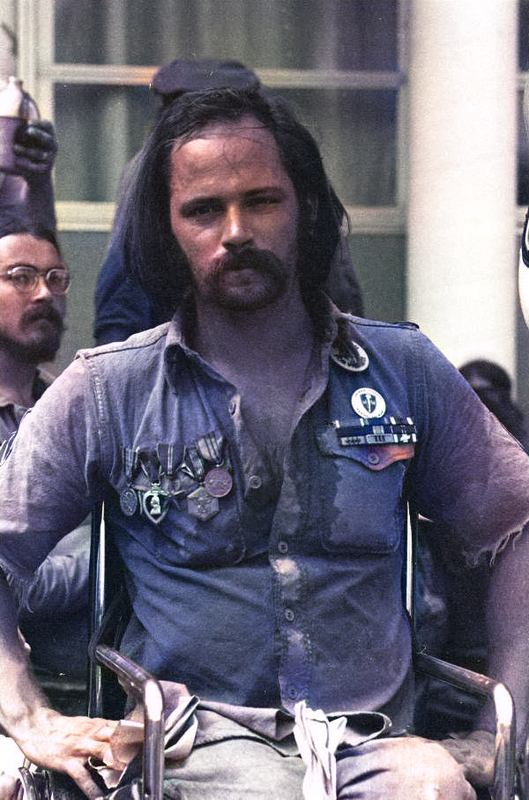
Leading the pack at the Republic Convention in Miami back in 1968, Marine veteran Ron Kovic in his wheelchair, led 1200 other veterans behind him as they marched a long route to protest the Vietnam War. It wasn’t a protest that was loud or full of riots, and the police even made sure to block off traffic to ensure the men were safe during their route to the hotel where the convention was being held. Kovic even gave a powerful and peaceful speech at the end of the route to address the politicians and the nation.
Come on Home, Boys

It was a monumental day on April 23, 1975, when President Ford announced to the entire U.S.A. that America was absolutely, resolutely, and officially done in the Vietnam War conflict. This poignant photo shows soldiers hearing for the first time on their static-y radios that they finally get to come home. And the U.S. wasted no time after the announcement from the president, bringing the boys out of Vietnam in huge groups on helicopters and every aircraft they could find in just a couple of weekends.
Real Images of War
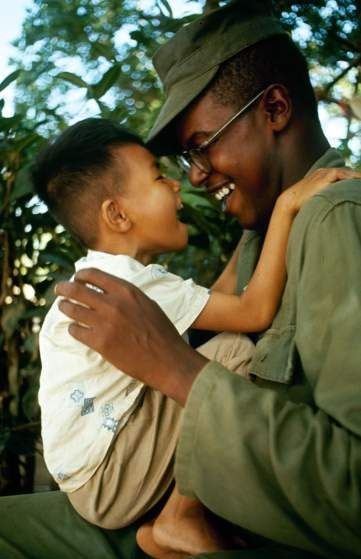
1965 brought about the harsh, escalated beginning of the Vietnam War, and LIFE magazine thought it pertinent to send out legendary photog, Paul Schutzer, to take raw photos of what was going on over there for 6 weeks. Paul’s job was to capture candid photos of what the Vietnam War really looked like so that Americans back home could see the reality of what happening. Paul captured every scene you can imagine, from the violent battles themselves to the more peaceful moments where soldiers were aiding innocent villagers.
Peace, Love, and a Flower Brigade

Flowers weren’t the only things used in the motto of a peaceful hippy protest dubbed “Flower Power” during the Vietnam War. A variety of toys, music and even candy was used just as often as flowers, with the idea that happy and bright items would always be a perfect contrast to war items like guns and stark military uniforms. While this movement hovered around Berkeley in California at the first of the war, by 1966, Flower Power had made its way all over the country, and by 1967, the first annual Flower Brigade Parade was initiated to honor those who were serving and had fallen in Vietnam.
Protestors Lose Steam

Unlike earlier shots in the Vietnam War, this protest wasn’t full of hopeful faces sticking flowers into guns or delivering prominent speeches full of optimism. By 1970, any hopes that protesting or any amount of draft-dodging could do anything to stop the Vietnam War had been dashed. The war raged on, became worse and worse, and it became clear to even laymen back home watching the coverage of the ongoing fight that America was way less prepared for this war than ever thought possible. Many began to believe that there was no end in sight.
Last Ride Out

Here we see an outside shot of just how gigantic the Hanoi Taxis that would finally rescue and fly out so many of the Vietnam War POWs really were. This Lockheed C-141 Starlifter aircraft had also been used exclusively to fly Bob Hope and his troupe back and forth to Vietnam every year, but the last rides this plane would give to those who had suffered so long under the hands of the enemy were the ultimate taxi ride ensuring those boys would never have to go back to the jungle.
Time for a Dip

A huge entertainment event was run of the mill for July 4th at the National Mall in Washington D.C., but in 1970, being that we were in the middle of the Vietnam War, things went a little differently. Bob Hope himself tried to create entertainment for the masses to distract them from the morose happenings of the war, but to no avail. By the end of the evening, college and high school students were elbows to elbow in the Reflecting Pool, high on drugs and ready for an end to the war.
And That’s a Fact, Jack!

When the beloved show, Duck Dynasty, was on the air, one of the fan favorites of the cast was Uncle Si. He made many references every episode to his time as a soldier in Vietnam. From jars of jalapenos to teacups, Si always talked about all the goodies his mother would send over in his combat boots. Though the war as we know was such a dark time in general for every soldier over there, Si managed to bring us more lighthearted anecdotes of his own time-fighting in the jungles.
This Jane was Anything But Plain
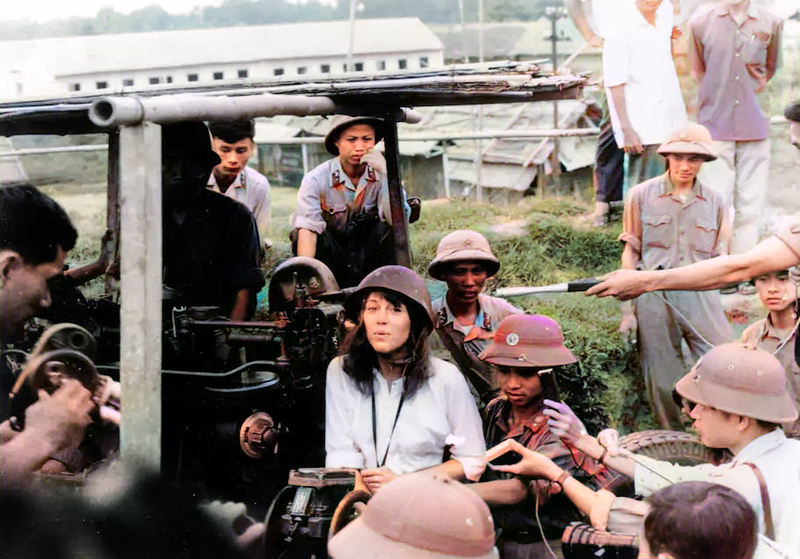
For the beginning of the Vietnam War, Jane Fonda had toured college campuses and anti-war protest events all over the country shouting about her ideas against the war. But she didn’t necessarily stand out until her infamous photo session with the enemy in Vietnam later in the 1970s, where she earned the nickname “Hanoi Jane”. That wasn’t her only brush with activism in her life though. Later, she would go on to support and protest with The Black Panthers, overtime working mothers, and Indian tribes all over the U.S.
Leave it to Beav!
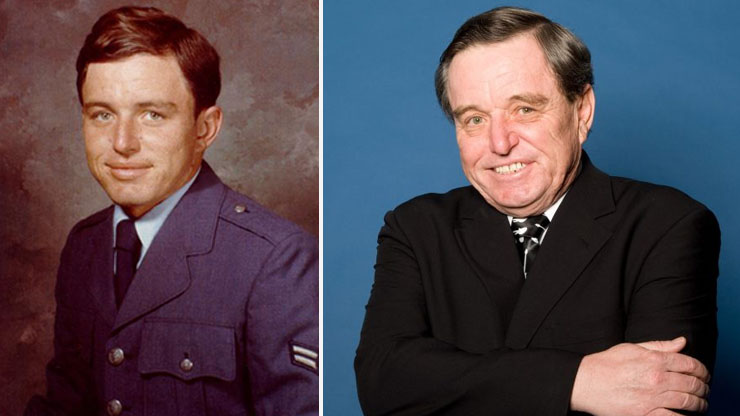
Did you know that The Beaver himself from Leave It To Beaver would go on to join the U.S. Air Force and was on inactive duty during the time of the Vietnam War? Jerry Mathers got lucky and didn’t have to go to the jungle, however, and was stationed in America rather than sent over to Vietnam. Though the source isn’t known, Jerry was actually declared Killed in Action in Vietnam in 1967 for a whole year before it was corrected, even though he never went.
The Real Wonder Woman

Heroes weren’t just the men of the Vietnam War. Iconic army nurse Kate O’ Hare Palmer is a true hero, fighting along the front lines to save even those soldiers that were way beyond saving. Kate ran at least 2 field hospitals in the thick of the war, directing and mending the worst of the worst injuries and devastating violence to be wrecked upon these human men. She survived the war herself and now, Kate is the head chair of the Women Vets Committee for the Vietnam Vets of America.
War Trauma Comes to the Silver Screen

Another extremely well-done film based around the Vietnam War on our list is The Deer Hunter, featuring legendary actor Christopher Walken. Most say that this is Walken’s best work onscreen. Walken even won an academy award for playing the role of a man torn beyond repair by heavy PTSD from the Vietnam War. It was a striking, sickeningly real depiction of just what war trauma can really do to an individual and how most of the time, that can turn out as something that can never be remedied.
Miss World Meets Vietnam
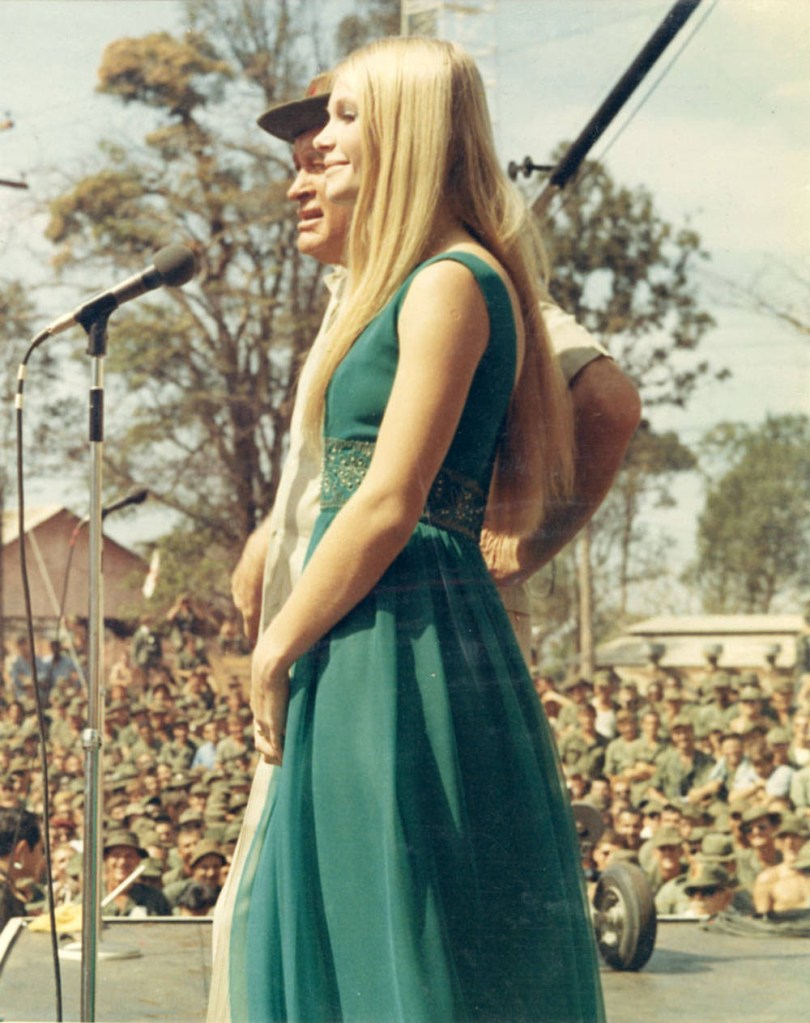
In another sweet example of just how important pups could be for the soldiers, we see a corporal here snuggling and smiling widely with his teeny tiny puppy. While dogs had many uses from a military standpoint during the Vietnam War, support animals could really be defined in a totally different way. As emotional and PTSD animals are used widely now, they were also super beneficial for mental well-being and health during the war back then.
Puppies Give the Best Snuggles
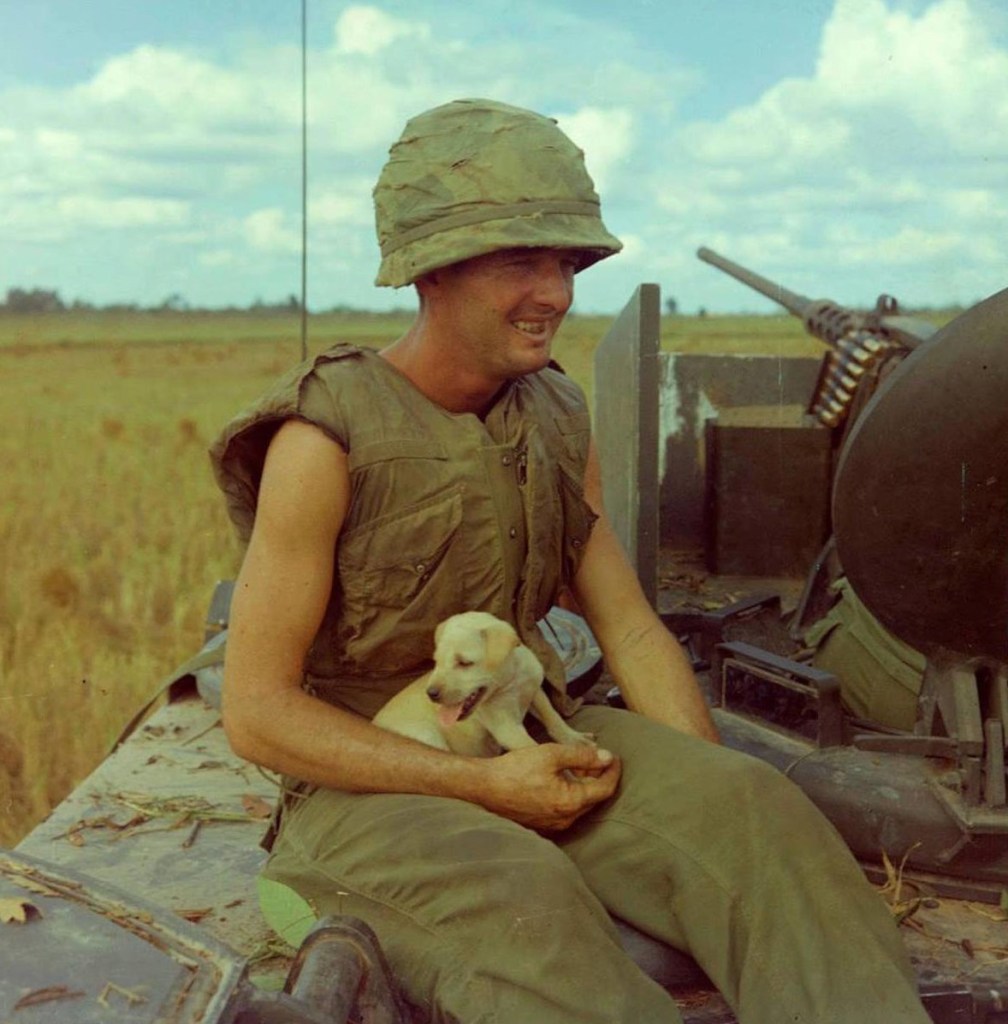
In another sweet example of just how important pups could be for the soldiers, we see a corporal here snuggling and smiling widely with his teeny tiny puppy. While dogs had many uses from a military standpoint during the Vietnam War, support animals could really be defined in a totally different way. As emotional and PTSD animals are used widely now, they were also super beneficial for mental well-being and health during the war back then.
Flowers Invoke Nobel Peace Prizes

Several photos taken during the Vietnam War during Flower Power protests have been nominated for Nobel Peace Prizes, and it’s easy to see why. These types of pictures capture profound candid moments in which something as seemingly silly as putting a small flower into the end of a rifle showcases the true divide and stress that befell America during the war. Soldiers allowed the peaceful action, and in seeing this, we are better able to understand both sides of what war looks like to those on the front lines and those waiting back home.
A Brief Moment of Joy
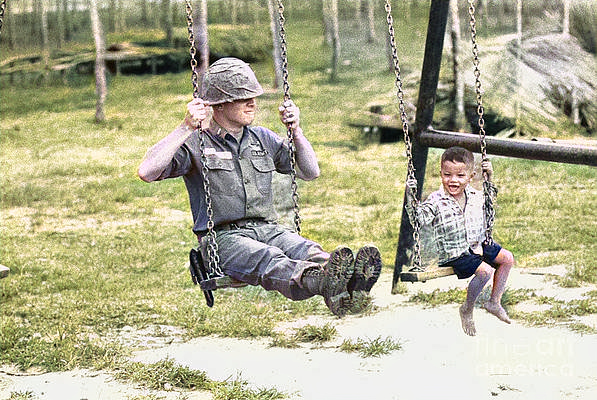
In this joyful picture, we get a delightful surprise—both the child of a war-torn village and a soldier in the middle of a traumatic battle is smiling gleefully as they try out a brand new swing set. Soldiers did much more during the Vietnam War than fight. When a base was near a village, for instance, troops would get together and build small parks full of things like swing sets, benches, and other playscapes for the neighboring kids to come and play on.
A Purple Heart and an Oscar…

We’ve all heard the name Oliver Stone, as it’s a big one. He’s the director behind so many blockbuster films that shake the industry up, but way before he earned that title, he was a hero in the Vietnam War. Though he joined the war later than most in 1967, Oliver still came away with a Purple Heart and a Bronze Star for his big-time efforts in the war. Like the work we see in movies today, back then, Oliver had just as much gumption to fight and make a difference.
Protests Turn Deadly
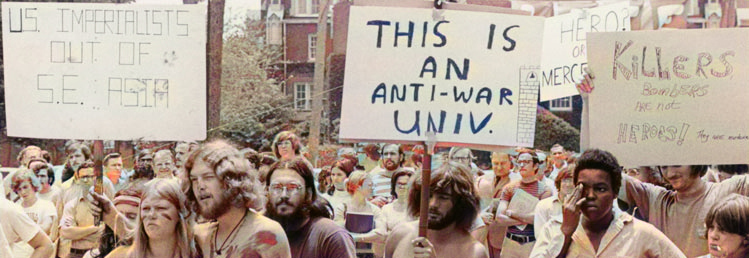
Anti-War protests were going on everywhere all over the country during the Vietnam War, and most were peaceful, but protests on college campuses became more and more rampant and uncontrollable as kids were being drafted off to war. The anger of not having a choice in being drafted was at its height between 18- to 22-year-olds. In Ohio at Kent State specifically, one of the most violent riots of any protest during the Vietnam War broke out, and several students were actually killed. An Anti-War March in Vain
An Anti-War March in Vain
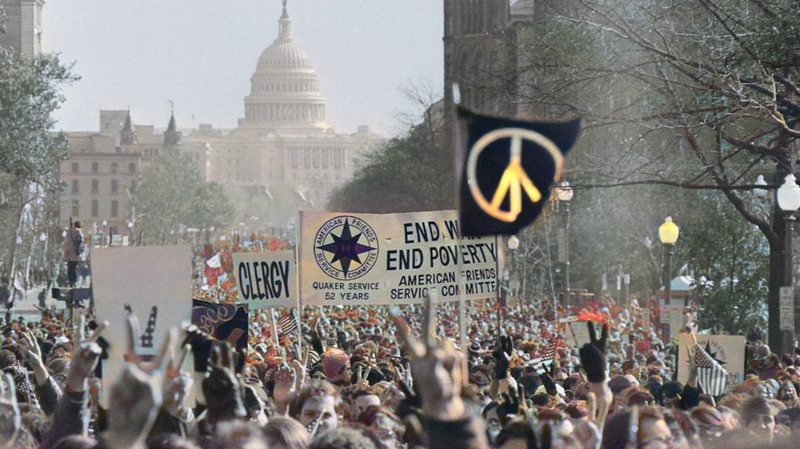
In 1969, the most massive protest of the Vietnam War befell upon Washington, D.C. Known as the Moratorium March, this massive crowd held signs and walked in complete silence down all the main streets in D.C., urging President Nixon to end the war. Curiously, even within just silence as part of the protest strategy, many of the protestors were sprayed with tear gas by the police. And at the end of the day, Nixon made a statement that no matter how big a protest became, it would never sway his decision on the war efforts.
Age is Just a Number
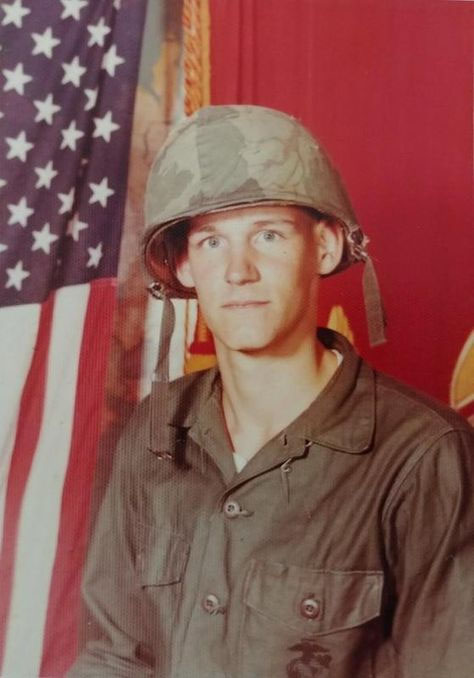
18 is the legal age to be drafted or to voluntarily sign up to be a soldier for the U.S.A., but the guy in this picture didn’t let that stop him. In an age where double checks and computer systems didn’t exist, it was all too easy for this 15-year-old to draft up a fake birth certificate stating that he was indeed legally old enough to enlist. And it worked. As seen here in his official military headshot, this teenager has just become a Marine.
Flower Power Loses its Luster

As the war wore on, hippies began to lose a bit of that peace they’d always come to protest with. Flower power just didn’t seem to be working on President Nixon to help convince him to end the Vietnam War, so protesters were upping their rally numbers, turning up the volume on their shouts against the war, and turning their marches to only taking their message as close as they could get to the President—Washington, D.C.
On to New Horizons

It didn’t take long after President Ford announced the end of the Vietnam War for the U.S. to get the soldiers and POW’s the heck out of the jungle. But in this serene shot of some of the last troops to be brought out of Vietnam, there is a different sort of solace in their expressions. Leaving those dangerous hills behind them that they’d been stuck in for a decade, hope had begun to resurface for the first time since the war had started back in the 60s.
Here is the direct link to the article on Investing Fuel: https://investingfuel.com/entertainment/rare-photos-from-the-vietnam-war-brought-to-life-with-color
<><><>
Thank you for taking the time to read this. Should you have a question or comment about this article, then scroll down to the comment section below to leave your response.
If you want to learn more about the Vietnam War and its Warriors, then subscribe to this blog and get notified by email or your feed reader every time a new story, picture, video, and changes occur on this website – the button is located at the top right of this page.
I’ve also created a poll to help identify my website audience – before leaving, can you please click HERE and choose the one item best describes you. Thank you in advance!



all were heros but never received the recognition we deserved. The hurt will never leave our minds no matter what anyone says. if you werent there then you couldnt know
LikeLike
We are the only ones that still care…My college educated sons never heard a word about the’Nam. I wish that I could visit the Wall next month, but I can’t. With several of my friends in ’82 we witnessed the dedication.
LikeLiked by 1 person
RIGHT YOU ARE ABOUT OUR CHILDREN. mINE ARE IN THEIR 40’S AND DON’T KNOW A DARN THING ABOUT THR ‘NAM…i WAS ALSO THERE IN ’82 …WELCOME HOME BROTHER….67/68.
LikeLike
I served with the 09th infantry division Mekong delta 67/68 also the 4 th infantry
Up north in Pleku close to Cambodia revived a 💜 Purple Heart at Dak To I’m proud to say it was a honor to serve with the bravest men on earth
LikeLiked by 1 person
I found no reference to Woody Hayes and his entourage who brought and narrated a video of ohio states victory over usc in the rose bowl 1969 . They were much appreciated at Quang Tri on jan 4 1969 . They all hit the sawdust floor after mistaking out going artillery for incoming . LILY
LikeLiked by 1 person
Most of us have more memories than photos.
LikeLiked by 1 person
This was a great article. My husband was in Vietnam in 68-69. His unit, the 1st Air Cav saw so much action. He received the Bronze Star and Purple Heart. Thank God he came home safe and sound. Thank you for sharing this story, as there were somethings he would not talk about. God bless you.
LikeLiked by 1 person
Is this going to be a book? I was in 9/59-12/63. Would love to read it if so
LikeLiked by 1 person
Nice collection! Might want to add Martha Raye and Adrian Cronauer. And more bands — one of my favorites was The Mamals (sic) from I believe the Philippines. The other great act featured Tazzie Hamilton, an older woman from New Zealand.
LikeLiked by 1 person
Very well done…Nam 67-69 USMC
LikeLiked by 1 person
Thank you! ❤️ 🇺🇸🇺🇸🇺🇸🇺🇸🙏🙏🙏 your article was spot on! 1st Cav 66/67 I was blessed to make it home!
LikeLiked by 1 person
My ex husband was my high school sweetheart. Even though we were not together when he joined the Marines and went to Nam we ended up getting back together and then married in 1971. He would never tell me much about his time in Nam, but there were nights he would wake up shaking and screaming out from nightmares. We eventually divorced after three years of marriage and having a daughter together because his PTSD was so bad, even though we didn’t realize that’s what it was back then. He ended up committing suicide when he was 35 and in his 4th marriage because of the PTSD and being sprayed by agent orange, he had horrible back problems. Our daughter was 15 when he died and has never really gotten over his death. Such a sad story!😢😢
LikeLiked by 1 person
Spc5 Collins , Ankhe , Vietnam 69-70 ,8Gp 88th Trans. Co. Brings back lot memories good and bad . Glad to be recognized for our part . It’s had to be hard to get all the facts right. But a good job still, thanks.
LikeLiked by 1 person
Where is the word, “Derrieres?”
LikeLike
In the title above the first picture:
Doughnuts, Daisies, and Delightful Derrieres
LikeLiked by 1 person
Pls ck out the captions under both photos as they were rewritten yesterday. If something else needs to be changed, please get back to me.
LikeLike
Quite the stories. Not all the truth but dam good.
LikeLiked by 1 person
Man some troops had fun in Vietnam, we never seen any stars out in the jungle 101st 1/502
LikeLiked by 1 person
This brought back memories of the two tours I spent there. I was fortunate to see most of the celebrities two Christmas’s in a row, however Martha Raye was my favorite. I was a Seabee with our home base was Red Beach DaNang and our second tour was mostly at HoiAhn with the Korean Marines where we built a complete encampment. I will continue to look up these articles because they remind me of my life while I was there. I
LikeLiked by 1 person
There are quite a few errors in this article. I am a former Donut Dolly, and I am a bit on the upset side of things about some of the misinformation included here. I would LOVE to correct the ambiguities in this article – as would a number of my fellow donut dollies. Please respond!
LikeLiked by 1 person
Diane, I didn’t write the article but I’d be glad to change any wording with the attached photos. Please submit changes to my email and I’ll make them in the article. john.podlaski@gmail.com
LikeLike
It’s more than wording that needs to be changed. It needs rewriting as to the Red Cross SRAO women/program. And “Derrieres?” Please remove that.
LikeLiked by 1 person
Pls ck out the captions under both photos as they were rewritten yesterday. If something else needs to be changed, please get back to me.
LikeLike
Good, Good!
LikeLiked by 1 person
This is the best app I ever had the best time reading in a long time it took me back in a good way thanks
LikeLiked by 1 person
How do I keep this article from slipping away? It was wonderful and want to keep it.
LikeLiked by 1 person
you can save the link to your favorite folder.
LikeLike
One of the best post I’ve seen on Vietnam! I got to see the Bob Hope show with Ann Margaret in Ton Son Nhut and it was an awesome experience after coming from the Quan Tri Province and Hue up North!
LikeLiked by 1 person
John McCain was not an Army solder. He was a Navy Pilot and was shot down on a mission over North Vietnam and became a POW after launching from the USS Oriskany (CVA-34).
Other than that one comment, I enjoyed the article and seeing the pictures. I, too, was a Navy carrier pilot flying 135 missions over the north.
LikeLiked by 1 person
corrected
LikeLike
John Macain was Navy not Army!
LikeLiked by 1 person
You could have left any reference to Hanoi Jane off. She doesn’t deserve to be mentioned with the solders that were there.
LikeLiked by 1 person
A lot of pretty pictures of people, I would have liked to hump with but the humping I did was a bit different.
LikeLiked by 1 person
Fantastic. Should show more.
LikeLiked by 1 person
As Walter Cronkite would say, ( That’s the way it is)
LikeLiked by 1 person
Mostly A+
199th-1st Cav-Combat Infantry
11B40-Grunt-1970
LikeLiked by 1 person
This is great. Has all sides posted, and much more important it tells you who is in. the picture. Really great post from start to finish.
LikeLiked by 1 person
really incredible pictures!!
LikeLiked by 1 person
I’ve seen many of these but not all of them. A trip back in time.
LikeLiked by 1 person
Your history is flawed, John McCain was not in the Army, he was a Naval aviator.
LikeLiked by 1 person
Great collection of photos and captions, with only a few corrections in some of the captions needed.
LikeLiked by 1 person
Want mccain a Navy pilot not an Army soldier?
LikeLiked by 1 person
corrected
LikeLike
Most of the information posted about Red Cross employees is incorrect.
LikeLiked by 1 person
my book
LikeLiked by 1 person
Thank you. Having spent my time there with 3rd MARDIV, I still feel intensely when I see pics and read experiences of those who served with me.
LikeLiked by 1 person
A great rendition of so many aspects of the time we were there.thank you
LikeLiked by 1 person
Way, way too many photos of Ann Margret and way too few of THE WAR. [cid:70fdf7c2-56ea-4777-9f60-46a14904e0e5] ________________________________
LikeLike
What we saw, what we did, blessed to make it home, Welcome home everyone. 101st ABD 1971.
LikeLiked by 1 person
No photo of Ann Margret. No cute puppies. This was THE WAR.

LikeLiked by 1 person
Yes, that was the reality, never saw any of those people. They didn’t come to Khe Sahn, Dong Ha, Cua Viet, I heard they visited, but never was in their presence.
LikeLiked by 1 person
The real war. Forgotten now on Memorial Day…. https://i.dailymail.co.uk/i/pix/2018/02/09/13/4906EDBB00000578-0-image-a-31_1518182123493.jpg
LikeLike
Way too many photos of Ann Margret and GI’s with puppies. Way too few views of THE WAR.
LikeLiked by 1 person
Memories are made of this — some good, some bad.
A great selection of pics
LikeLiked by 1 person
The Vietcong stand down pic is a terrible joke, that never happened. Come on you need to take this crap off your site before you lose your credibility.
LikeLiked by 1 person
re.oved
LikeLike
The Vietcong Stand down picture is a total joke. Come on, take this crap off your site. Its terribly inaccurate.
LikeLike
I noticed some misinformation in some of the captions, 1/3 of troops were surfers, come on man, I doubt that. And 25,000 marines killed in Vietnam, the actual number was a little less than 15,000. The Black Panthers being nice, bullcrap. You do to good of a job telling us about Vietnam to not review what you put put. Sorry, but you are better than this.
LikeLiked by 1 person
Out of 99 photos, you chose to critique three, on the number of VN soldier surfers, the number of Marine deaths, and the Black Panthers anti-war stance. Adding insult to injury, you chastise pdoggbiker for not researching and editing each photo’s caption, for its accuracy. Really?! Pdoggbiker just spent his time and effort locating and providing the photos to us and never said that he was responsible for the captions. The least that you could do is to thank pdoggbiker, for his time and effort. While you’re at it, perhaps, you could provide your statistics and sources, for those you are questioning. Nit pick, nit pick, nit pick…….must be very tiring.
LikeLiked by 1 person
I can list many more but did not want to beat a dead horse. I know this man and he has provided many good stories over the years but this one is terrible. So you are being a bore and yes I stand behind my comments.
LikeLiked by 1 person
If you didn’t agree with the photos, then, all that you had to do was to provide your own statistics. You didn’t have to “shoot the messenger” for only providing a gratuitous service to us. I suspect that most vets appreciate what pdoggbiker does, including providing these photos. As for your personal insult, surely, you can do better than that, at this stage of life.
LikeLiked by 1 person
Thanks for your support, Skytrooper70
LikeLiked by 1 person
My pleasure. For the life of me, I just don’t understand how some vets can critique your offerings, as you are doing this, for FREE, and on your own time. It’s not as if the complainers are paying for this blog. I suspect that the same people, who complain/critique, would show up at a free barbeque and complain that the host didn’t have their preferred brand of beer. I realize that I can be accused of overreacting but so be it. I have had it with those veterans disrespecting and demeaning other vets, such as yourself, who only are trying to provide all vets a place to contemplate and to share our Vietnam war time experiences. Keep up the good work, for those of us, who appreciate what you are doing.
LikeLiked by 1 person
Thank you, sir.
LikeLiked by 1 person
corrections made.
LikeLike
I enjoyed watching it. I was never at a show or donut dolly. I could relate to a few of the pics but I guess there was another part of Vietnam that I never saw. 11B
LikeLiked by 1 person
I’m navy but relate 2 the Vietnam war
LikeLiked by 1 person
While I enjoyed the article a lot…. I found that at the end I was feeling quite depressed. It is sad to think that most sufferers of PTSD caused by war will not ultimately overcome it.
I wish the world could get past deadly conflict!
LikeLiked by 1 person
So many inaccuracies.
LikeLike
Then why don’t you clarify them for us?
LikeLike
Very well done.
LikeLiked by 1 person